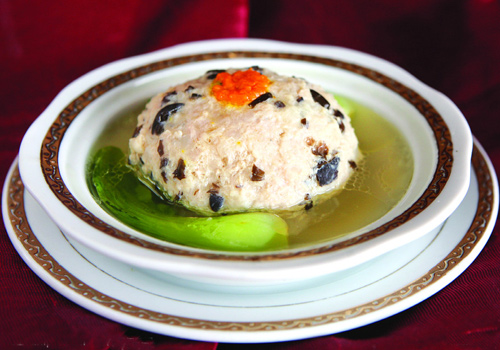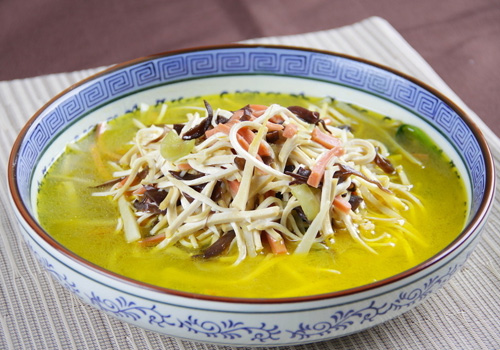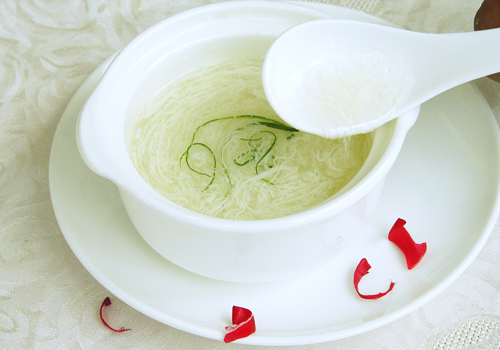A Bite of China – the Secret of Kitchen Knife
2012-08-30China Food
Chinese never consider cooking as a task. They have a great passion for delicate combination of appetite-raising color, aroma, and flavor of food. The processing of a delicious dish may involve a range of cooking methods, smart use of ingredients and seasonings, precise control of time and heat, etc. There are so many secrets hidden in kitchen. One of eight Chinese cuisines, Huaiyang Cuisine may reveal one secret – the secret of kitchen knife to you. Some one thousand years ago, coal started its life in kitchen. But China’s chefs had been used to treasure fuels since ''firewood'' age. This requires chefs to transform food material into suitable portion to match up different cooking methods. The impressive feature of Huaiyang Cuisine is clever use of kitchen knife. It gives so much attention to the transformation of food material that a good chef must achieve excellent cutting skills. The importance of kitchen knife is reflected in widely-known ''Yangzhou Three Knives'' (扬州三把刀, kitchen knife, pedicure knife, and hair-cuttng knife), which can be found in alleys of Yangzhou, where the Huaiyang Cuisine was originated. Kitchen knife in the hands of Yangzhou chefs means more work of art than a simple tool.

Located on the north bank of Yangtze River in east China's Jiangsu Province, Yangzhou is not only famous as a tourist destination with classical gardens and Slender West Lake but also the undisputed home of Huaiyang Cuisine. Huaiyang Cuisine is presented in every corner of Yangzhou, from Museum Huaiyang Cuisine (淮扬菜博物馆), Dongguan Street (东关街), bank of Grand Canal (大运河), Runyang Bridge (润扬大桥) to Yechun Teahouse (冶春茶社) to each household. Western chefs have different cutting tools to deal with different food materials while Chinese chefs have only one in kitchen – kitchen knife. Cutting methods involves far more than slicing, dicing, chopping, and mashing. Flat-cutting or inclined-cutting, subtle difference in cutting methods may cause discomfort on our sensitive taste buds and teeth. Hundreds years ago, Yangzhou is a trading port for salt trading thanks to the Grand Canal, which links Beijing with Hangzhou. Numerous businessmen flocked to Yangzhou and became wealthy through salt trade. At the same time, they brought chefs and food materials of their hometowns, which made Huaiyang Cuisine to the taste of both northerners and southerners. Without political statues in the society at that time, rich salt businessmen began to compare gardens and culinary skills of household chefs with each other. That’s possibly why there are so many traditional delicious dishes today. Boiled Tofu Shreds (大煮干丝), Stewed Large Meatball (清炖狮子头) and Wensi Tofu Soup (文思豆腐羹) are just three of the most that illustrate how important cutting skills can be in Huaiyang Cuisine.

Apart from steamed buns, Boiled Tofu Shreds is served on the breakfast table of Yangzhou. Boiled Tofu Shreds is also known as Dried Tofu Shreds. It is by no means easy to cut them into countless same-size shreds. Cutting skill is of course crucial, what’s more important, a peaceful mind. It is normal to see the finger skin of a culinary novice wore down by kitchen knife. You can imagine. Hundreds of tofu shreds are scattered only when they are soaked into water. After the bitter is washed away, they will be embraced by delicate flavors. Each piece of tofu is loaded with superior taste and nutrition in clear chicken soup and fresh ingredients.
Large Meatball’s reputation stretches far and wide. It is also called ''Lion's Head''. The commonly used cutting method – ''flat cutting'' is employed. This dish can be a test of chefs’ cutting skills. Streaky pork is expertly cut rather than chopped into pomegranate seed-sized portions so that the particles can be more easily pinched into meatballs. After simmered in prepared soup for two hours, the meatballs are still round. But it’s not the ending. The meatballs will be fish out and put into another pot of clear chicken soup to have a more pure taste.
Large Meatball’s reputation stretches far and wide. It is also called ''Lion's Head''. The commonly used cutting method – ''flat cutting'' is employed. This dish can be a test of chefs’ cutting skills. Streaky pork is expertly cut rather than chopped into pomegranate seed-sized portions so that the particles can be more easily pinched into meatballs. After simmered in prepared soup for two hours, the meatballs are still round. But it’s not the ending. The meatballs will be fish out and put into another pot of clear chicken soup to have a more pure taste.

Wensi Tofu Soup is a time-honored traditional Huaiyang dish and a healthy dish for the elderly and kids. It melts in your mouth instantly. Whensi Tofu Soup is perfectly cooked with sliced same-size tofu, mushroom, bamboo shoots, ham, chicken breast. When the tofu slices are put into clear water, they are scattered like white clouds, and some say, it is a Chinese landscape painting. Some can be as thin as hair.
---By Sunny (VisitOurChina)




